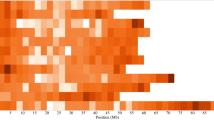Abstract
Isozyme markers were used to survey the genetic variability of non-bitter potatoes in 10 subsistence fields of Andean farmers at 3600-3850 m above sea level. Sixty-seven percent of the varieties were tetraploids corresponding to the speciesSolanum tuberosum ssp.andigena, 14% were triploids, probably corresponding to the speciesS. x chaucha, and 13% were diploids corresponding to the speciesS. stenotomum, S. phureja, andS. goniocalyx. The isozyme information served to determine the consistency of the folk naming system. We found a high degree of correspondence between farmer identification and electrophoretic phenotypes. The consistency of the folk system in electrophoretic terms depended on the farmer who was interviewed. The most common incongruity consisted of calling different electrophoretic phenotypes by the same variety name, leading to a slight underestimation of genetic variability present in the fields. The amount of variability observed in the sample of the Andean potato population was superior to that present in North American and European varieties. This was measured in terms of number ofalleles, number of electrophoretic phenotypes and percent of heterozygosity. This finding supports the impression that a substantial amount of yet unexploited variability remains in Andean potato populations.
Resumen
En este trabajo se da a conocer los resultados de un estudio genético sobre variedades de papa dulce en los Andes, realizada por medio de marcadores isoenzimáticos en parcelas de subsistencia localizados entre 3600 y 3850 metros sobre el nivel del mar. Se encontró que 67% de las variedades muestreadas eran tetraploides de la especie S. tuberosum ssp. andigena, 14% triploides probablemente de la especie S. x chaucha, y 13% diploides de las especiesS. stenotomum, S. phureja andS. goniocalyx. La información isoenzimática fue útil en la evaluatión de la precisión del sistema folklorico para identificar variedades. Se encontró un alto grado de asociación entre el sistema de clasificación usado por el campesino para denominar sus variedades, y los fenotipos electroforéticos. La precisión del sistema de identidad folklorico en tℰminos electroforéticos dependió del campesino entrevistado. La discrepancia mas frecuente entre los dos sistemas de nomenclatura consistió en llamar diferentes fenotipos electroforéticos con el mismo nombre varietal, lo que resultó en una subestimación de la variabilidad genética presente en los campos. El nivel de variabilidad observado en la muestra de papas de la población andina fue superior al observado en variedades nortea-mericanas y europeas. La variabilidad se midió en base al número de alelos, número de fenotipos electroforéticos y porcentaje de heterocigosidad. Estos resultados están de acuerdo con la impresión general de que todavía existe mucha variabilidad en variedades de papa andinas que no ha sido aún explotada.
Similar content being viewed by others
Literature Cited
Alcorn, J. B. 1984. Huastec Mayan ethnobotany. Univ. Texas Press, Austin.
Berlin, B., D. E. Breedlove, and P. H. Raven. 1974. Principles of Tzeltal plant classification. Academic Press, New York.
Boster, J. S. 1984. Inferring decision making from preferences and behavior: an analysis of Aguaruna Jivaro Manioc selection. Human Ecol. 12:343–358.
—.. 1985. Selection for perceptual distinctiveness: evidence from Aguaruna cultivars ofManihot esculenta. Econ. Bot. 39:310–325.
Brush, S. B. 1986. Genetic diversity and conservation in traditional farming systems. J. Ethnobiol. 6:151–167.
—, Carney, H. J., and Z. Huaman. 1981. Dynamics of Andean potato agriculture. Econ. Bot. 35:70–88.
Correll, D. S. 1962. The potato and its wild relatives. Texas Research Foundation, Renner, TX.
Douches, D. S., and C. F. Quiros. 1987. Use of 4x-2x crosses to determine gene-centromere map distances of isozyme loci inSolarium species. Genome 29:519–527.
—., and —. 1988. Genetic recombination in a diploid synaptic mutant and aSolarium tuberosum x S. itchacoense diploid hybrid. Heredity 60:183–191.
Hawkes, J. G. 1979. Evolution and polyploidy in potato species. Pages 637–646in J. G. Hawkes, R. N. Lester, and A. D. Skelding, eds., The biology and taxonomy of the Solanaceae. Linnean Soc. Symp. Ser. No. 7.
Huaman, Z., and R. W. Ross. 1985. Updated listing of potato species names, abbreviations and taxonomic status. Amer. Potato J. 62:629–641.
Jackson, M. T., J. G. Hawkes, and P. R. Rowe. 1977. The nature ofSolarium x chaucha Juz. et Buk., a triploid cultivated potato of the South American Andes. Euphytica 26:775–783.
Johns, T. A. 1985. Chemical ecology of the Aymara of western Bolivia: selection for glycoalkaloids in theSolatium x ajanhuiri domestication complex. Ph.D. diss., Univ. Mich., Ann Arbor, MI.
—., and S. L. Keen. 1986. Ongoing evolution of the potato on the Altiplano of western Bolivia. Econ. Bot. 40:409–424.
Oliver, J. L., and J. M. Martinez-Zapater. 1984. Allozyme variability and phylogenetic relationships in the cultivated potato (Solarium tuberosum) and related species. PL Syst. Evol. 148:1–18.
Quiros, C. F., and N. McHale. 1985. Genetic analysis of isozyme variants in diploid and tetraploid potatoes. Genetics 111:131–145.
Stegemann, H., and V. Loeschcke. 1977. Das europäische Kartoffelsortiment und seine Indexierung. Potato Res. 20:101–110.
Author information
Authors and Affiliations
Rights and permissions
About this article
Cite this article
Quiros, C.F., Brush, S.B., Douches, D.S. et al. Biochemical and folk assessment of variability of andean cultivated potatoes. Econ Bot 44, 254–266 (1990). https://doi.org/10.1007/BF02860490
Received:
Accepted:
Issue Date:
DOI: https://doi.org/10.1007/BF02860490




